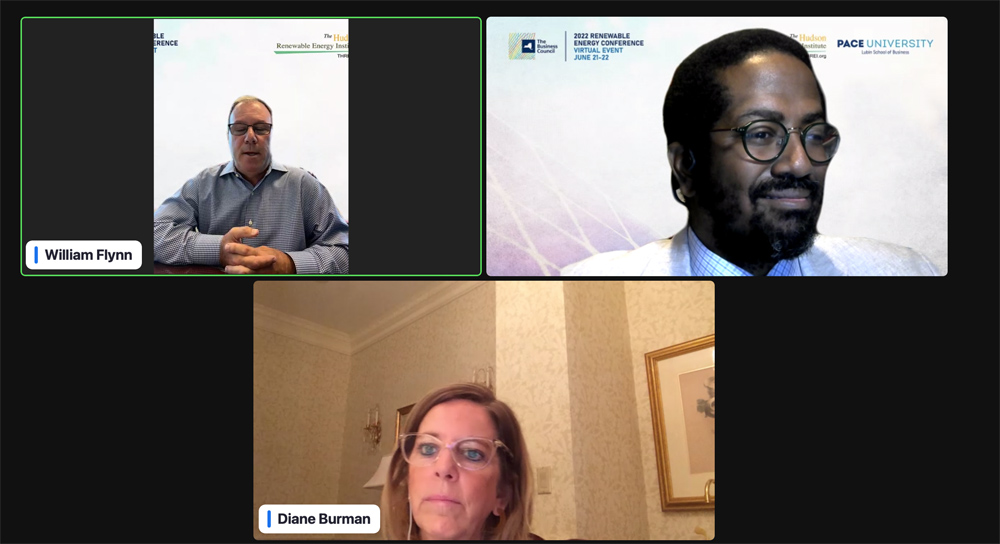WASHINGTON — Former FERC Commissioners Norman Bay and Colette Honorable recounted war stories and made predictions about where their successors are headed on market and transmission policy Wednesday at the American Clean Power Association’s Energy Storage Policy Forum.
Bay, who served from 2014 to 2017, including a stint as chair, and Honorable (2015-17) were joined by former FERC staffer Christy Walsh, now senior attorney and director of federal energy markets for the Natural Resources Defense Council’s Sustainable FERC Project.
One recurrent topic was FERC’s April Notice of Proposed Rulemaking on transmission planning and cost allocation (RM21-17) and its June 16 NOPR on improving transmission providers’ interconnection processes (RM22-14).
Pivot on Right of First Refusal
Bay said he was surprised that FERC’s April NOPR proposed reinstating transmission providers’ federal right of first refusal (ROFR) to construct transmission projects — a retreat from Order 1000’s attempt to inject competition. (See ANALYSIS: FERC Giving up on Transmission Competition?)
Bay, a partner with Willkie Farr & Gallagher, said there are two possible explanations for the shift in the NOPR, which was approved on a 4-1 vote, including the commission’s three Democrats and Republican Commissioner Mark Christie. Republican James Danly dissented.
“One is that, as a policy matter, the commission was concerned that this emphasis on competition was having this perverse policy incentive, where it was incenting transmission owners to basically build local reliability projects, and not to build the more ambitious, and frankly more helpful, regional — or even interregional — lines,” Bay said during the discussion, which was moderated by Jason Burwen, ACP’s vice president of energy storage.
The second possibility, Bay said, is that “there was a commissioner who felt very strongly about taking a step back from the removal of the federal ROFR, and basically insisted on this policy position. And to keep that vote, the decision was made to put into place this policy change.”
The June NOPR, which seeks to reduce delays and increase cost certainty for generation developers, was approved unanimously — a rarity since Danly, who has dissented on most rulemakings, joined the commission.
“Five votes on a NOPR like this is significant,” said Honorable, now a partner with Reed Smith. “[For a] NOPR as important and significant as this one, having every commissioner on board is key to provide certainty, and also to provide the proper foundation for FERC to build on.”
But, she added, unanimous support of the NOPR does not mean the final rule will also receive five votes. “You start all over,” she said.
Comments Needed
Honorable encouraged stakeholders to provide comments in response to the two NOPRs and dockets involving energy storage, noting that commission orders must be based not only on the law but also on “what the record says.”
“Your real-life anecdotal experiences about ways in which energy storage has been leveraged in places where transmission wasn’t as robust, that’s critical,” she said. “So, I would urge you to not sit on the sidelines and wait for someone else to put that in there — that you make sure it’s in the record, so that it can be leveraged by those commissioners that are seeking to build that pathway more robustly for storage as an alternative.”
Walsh said stakeholders should also seek to meet with FERC commissioners and staff before filing their comments. “A lot of times you can have a two-way conversation with commissioners and staff, and they can ask you questions about the point you’re making, and they can help you really see exactly what they need to hear in those comments,” said Walsh, who served as an adviser for former Chair Jon Wellinghoff, deputy general counsel and director of the Division of Policy Development during her nearly 19 years at the commission. “This is a rulemaking so there’s no, ex parte [prohibition]. Nothing that’s said in those meetings can be used without you then writing them down and submitting them in comments.”
Market Design
Burwen asked the panelists to predict what might result from FERC’s April order directing CAISO, ISO-NE, MISO, NYISO, PJM and SPP to report on how their system needs are changing due to shifting resource mixes and how they intend to fulfill them (AD21-10). (See FERC Asks RTOs for Plans on Changing Market Needs.)
Walsh predicted the docket would prompt changes but said it’s unclear whether they will be dictated by FERC or proposed by individual RTOs.
“FERC has done a white paper, four technical conferences, and now this order directing reports,” Walsh said. “That’s a significant amount of FERC staff time and industry time, and they would not be doing that unless they had intention to move forward with something.”
In previous orders directing reports, Walsh said, “sometimes the RTOs do the reports and kind of see their own flaws by doing some self-reflection and start fixing it themselves.”
Walsh said she expects more emphasis on using the energy and ancillary services markets, “so that you are really providing services in the hours that they’re needed, rather than in three years, or in case of New York, six months beforehand [through capacity markets]. … I think that we are coming to a system that is going to shift from hour to hour based on load and the resources, and we just need to be more dynamic.”
Capacity Accreditation
The panel also discussed FERC’s two June 16 NOPRs intended to improve the bulk power system’s protections against severe weather risks. One proposes to direct NERC to modify reliability standard TPL-001-5.1 (transmission system planning performance requirements) to set expectations for long-term planning by utilities (RM22-10). The second directs transmission providers to submit one-time reports describing how they assess and mitigate their vulnerability to extreme weather (RM22-16, AD21-13). (See FERC Approves Extreme Weather Assessment NOPRs.)
Bay said the issue of capacity accreditation — the subject of RTO-specific effective load-carrying capability (ELCC) rules — will require input from FERC as well as NERC.
“I don’t think NERC can do it all, because the issue here is not only technical, involving engineering, but it’s also economic,” Bay said. “I think there is an opportunity for FERC to step in and basically standardize the rules … but it would be difficult. It would be contentious, [but] it might be in the long run better than letting each RTO kind of figure out its own path forward.”
Honorable said she would welcome standardized rules. “Having stepped down from the 888 tower [FERC headquarters], it’s rough out here when you have to deal with a number of RTOs and ISOs that have different frameworks, different rules, different procedures. It’s cumbersome; it’s clunky.
She said FERC could provide “some structure … at the outset, and then leverage other resources. Maybe there is a role for NERC to play in the very technical evolution of it. But I’m concerned that if FERC rides herd over all of it, it could, it might take longer than it should.”
Walsh suggested FERC could have different rules for single-state ISOs in California and New York. “The states are really driving what resources are going to be on line, so it seems to me that, for example, the ELCC in New York might be different than any ELCC in ISO New England or PJM.”
State-Federal Relations
No discussion of FERC would be complete without discussing the perpetual tension between state and federal policymakers.
Honorable said states could become allies of FERC if the agency addresses inefficiencies in market operations and transmission planning across regional seams.
“That’s a place where we can really gain support from states who are grappling with the reliability impacts and the resilience outcomes as a result of long tenured congestion and the uncoordinated ways in which the seams are operating,” she said. “That’s an area that definitely could use more love and attention.”
Walsh praised FERC for creating the state-federal task force on transmission, and the transmission planning NOPR for creating “a really robust process for states” to have input.
But she said the state commissions need FERC guidance on the minimum set of benefits that the system should be planning for.
“State commissions are overburdened,” she said. “Asking the state commissions to figure out [transmission] benefits that aren’t immediately identifiable easily, it’s going to be hard for them.”

